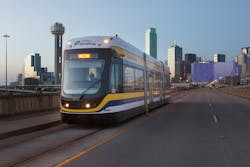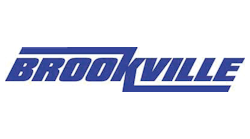Rail vehicles continue to develop to not only attract riders, but to also make the them run more efficiently and effectively.
On-board technology
“Wi-Fi connectivity is something that is part of our day-to-day world outside of trains, but it is also inside of trains now. We’re not the only ones offering this obviously, but this is something that is implemented in many projects that we have,” said André Thibault, head of vehicle platform design – Americas, Bombardier.
“One of the things that we are proud of in some of passenger coaches is we’re increasing the bandwidth and speed of the Wi-Fi access. There is enough bandwidth for all passengers to be using it at once. That is something that we see as a common demand,” said Michael Cahill, president of Siemens Rolling Stock.
Adding Wi-Fi isn’t simply added so passengers are able to scroll through social media on their phones.
Cahill said, “The use of digital data and the use of better information to passengers is something that is coming across the board in reaction to their passenger’s requirements and desires. There is a need to get more modern, innovative displays that give them real-time information. For the example is telling them what the next stop is and what the stop after that would be.”
Cahill explained that real-time information is something that is valuable for riders who aren’t regular commuters or are new to line and need more information.
“Along with this Wi-Fi connectivity comes a series of information that is now becoming available and connects the train to the wayside,” added Thibault, the train system can be monitored as well. “Information can now be transferred to a central control location and basically there can be a lot of action using that information, whether it is dispatching support, dispatching maintenance activities or also improving passenger flow. One of the parameters that is being monitored for example is the load of the cars, so how many people are on board so that way central control can basically advise and send messages at stations to say if the next train is full, half-full or which car should be boarded and therefore help passenger movement on the station. In rush-hour for certain cities like New York, which could be very helpful.”
Energy storage and automation
Developments in rail technology has also allowed for systems to become more flexible.
“I think that our most impressive new feature is our on-board energy storage system,” said Adam Mohney, marketing specialist at Brookville Equipment Corporation. “It enables off-wire applications for streetcars, one of the challenges that a lot of our customers face is implementing a streetcar where there is preexisting infrastructure or there might be a spot in their city along the line that they want the streetcar to travel, but don’t necessarily want the overhead catenary infrastructure installed in the area.”
Cahill said that Siemens also has received interest from energy storage. He said that while not every agency is interested in it, they are seeing a rise for it on a case-by-case basis.
In the future of transportation – not only in rail, but also with bus and cars – is developing automation.
Thibault explained that Bombardier has been steadily increasing its manufacturing of automated vehicles. Around ten years ago Bombardier had a few automated trains running, but now the interest is booming. “Automated metros are clearly a trend, people are asking for it, mainly because a large cost for agencies and an important liability is their staff. Automated trains give flexibility in operation and obviously reduces their cost in the long run.”
Agencies that utilize automation don’t require as many people to run their rail lines. They can have a person dispatch a train without needed to have an actual operator on-board.
“What I’ve seen in the United States is that they’re moving doors and train control systems that are allowing having unmanned train operation in the future, but they are not moving right away,” Thibault said. “For multiple reasons, one of them of course is that they still have to deal with unions and keeping certain types of jobs. The other one is public perception of seeing a train arriving with no driver on it.”
Thibault said to go around those issues Bombardier works to further enhance the agencies current operations along with new rail lines.
“Typically (we’re) reducing the workload of the driver and the accountability of the driver when stopping the train. Automating this process is preventing human error. Existing authorities are not making the move to fully automated yet, so it is a gradual process,” Thibault explained. “In the United States there are not that many new metro lines, but for example the Second Avenue System in New York will be much more automated. The driver will have less to do to make the train start and stop. The driver will basically just have to acknowledge to start the train and the train will actually stop itself.”
Improving safety
One area in which the industry is constantly keeping an eye out for developments is safety. In the event of a rail accident – the important factors are protecting both the train operators and the passengers. Siemens has been developing crash energy management that is featured in almost every rail vehicle.
“Nobody wants to crash and everybody does what they can to avoid it, but in some cases the fault is beyond the agencies behalf,” explained Cahill. “When there are accidents and the key focus is on absorbing that energy correctly so that you keep everybody safe. In the front of the train with the drivers and operators we put a bunch of safety elements in there so that you can absorb the energy rather than having them exposed in a high energy crash situation.”
Bombardier has also developed a crash-absorbent technology. Thibault said that Bombardier has worked to not only meet the standards for safety, but exceed them in certain cases.
“For example our newest bi-level rail car running currently in Toronto, has crash energy absorbent elements of the vehicle which allow to basically reduce the deceleration rate or the risk of injuries in case of a crash. It protects the driver, but it also protects the passengers on-board in case of accident,” said Thibault. “Therefore the energy being absorbed at the front end in front of the driver allows to reduce the risk of injuries.”
Thibault added that the FRA doesn’t currently require passenger rail vehicles to have crash energy management.
“There has been quite a lot of discussion over the last few years about making crash energy management a mandatory requirement, but at this point we are basically anticipating the next generation of legislation on the safety regulations,” said Thibault.
Future of rail
"I do believe that there is more acceptance and demand for mass transit. I think that the demand for passenger comfort and the liability in the terms of guaranteed travel times and I think that agencies are responding correctly," said Cahill. "For the layout I think that the most we have with light rail, streetcars I think that no one mode will be more prevalent than the other. I do think that we will have mainline rail to replace a lot of the shorter distance airplane travel. I think that airline travel has become quite congested and the reliability for on-time performance is lower than it used to be and people are beginning to realize that rail offers a good alternative. There is an uptick coming and it has already started and I think that it will continue to increase. While it takes an hour to fly and two hours by train, but when you factor in check in time it is more efficient."
Mohney echoed the idea that rail was going to continue becoming a large spotlight in the transit world. "I think as a manufacture we are very optimistic about the future of passenger rail and especially streetcar projects, as those impact us the most. We’ve seen evidence that they can improve transit systems and have held together well, in addition to that they provide economic growth in many cases for the cities and a byproduct of that that we feel is jobs for suppliers for Brookville so we are very optimistic that the future is bright for streetcar production in the United States."
Cahill added that he thinks that it takes initiative from both transit agencies and politicians to respond to the demand from passengers and commuters. "I think it takes the bravery from politicians because it involves capital spending and ventures and political. I think that at the end of the day the capital funding that requires long-term thinking at the political level to see the benefits and respond accordingly."






